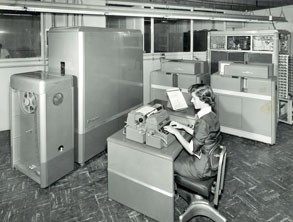AI wouldn’t be able to beat the world’s best human chess player for 46 more years, but it was game on in 1951 when an engineer challenged a computer to a $1,000 series of matches. The machine was rudimentary, so the acceptance of the wager came with some suspect conditions. From the November 12, 1951 Brooklyn Daily Eagle:
“Washington–Engineer Donald H. Jacobs, who challenged an electronic ‘brain’ to a $1,000 chess tournament, agreed today to follow the machine’s ring rules, ‘but won’t teach the thing how to play chess.’
Jacobs, president of the Jacobs Instrument Company of nearby Bethesda, Md., said he was looking forward to matching wits with CRC-102, the ‘brain’s’ technical name.
The only hitch was that the ‘brain’s’ second–the Computer Research Corporation, Torrence, Cal.–said that Jacobs would have to reveal his ‘chess system’ in advance.
‘I’m not going to give away my system to the machine,’ Jacobs said. ‘With that knowledge, any mortal chess player, much less the ‘brain,’ could win with no trouble.’
Jacobs made his ‘gentlemen’s bet’ for the man-versus-machine struggle over 20 games of chess to prove that man still can outthink a machine–at least over a chess board.
‘Although I am a poor chess player,’ he said, ‘pure egotism makes me unwilling to concede that a computing machine can play better than I can.’
CRC-102 promptly accepted the challenge. Engineer Richard E. Sprague, a director of Computer Research, said his ‘champion’ will take on Jacobs ‘any time, any place…and will take him apart.’
Computer Research, which has just developed the first portable electronic digital computer, claims that the ‘brain’–among its other talents–is an unbeatable chess player.
Sprague laid down three ‘ring rules,’ however, before CRC-102 will meet Jacobs in combat.
1. A time limit on the match so that the human contestant doesn’t take ‘a year or so to make up his mind on a move.’
2. Permission to tell the ‘eyeless’ machine what move its human adversary has made ‘so he can make the proper countermove.’
3. Jacobs must provide CRC-102 with his chess system.”

